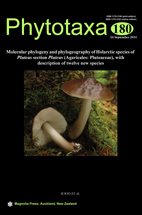| Phytotaxa ISSN 1179-3155 (print); ISSN 1179-3163 (online) | |
|
A rapid international journal for accelerating the publication of botanical taxonomy |
| Phytotaxa ISSN 1179-3155 (print); ISSN 1179-3163 (online) | |
|
A rapid international journal for accelerating the publication of botanical taxonomy |
|
0Home | Online content | Editor | Information for authors | How to order0 |
|||||||||||||||||

Buy
a copy of this volume |
Phytotaxa
180 (2014)
180 (1): 001–085 (24 September 2014) Monograph Abstract The taxonomy and
phylogeography of Pluteus section Pluteus in the Holarctic
region was investigated using morphological and molecular data. Over 300
specimens spanning the major areas of boreal and temperate forests of the
Northern Hemisphere were studied and nrITS and tef1 were obtained for
phylogenetic analyses. In order to stabilize the taxonomy of the group all
available type collections were studied and, if possible, sequenced. A total
of 26 species occurring in Eurasia and North America were recovered in the
phylogenetic analyses. Twelve species are described as new (Pluteus
rangifer, P. elaphinus, P. hibbettii, P. eos, P. orestes, P.
methvenii, P. shikae, P. kovalenkoi, P. leucoborealis, P. sepiicolor, P.
oreibatus, P. atrofibrillosus), one is provisionally named (P.
parilis) and one variety is raised to species rank (P. americanus).
In many cases separation of the species based on morphology alone is
challenging. In general, tef1 distinguishes the species better than
nrITS. Structured infraspecific genetic variation was detected in the nrITS
phylogenies for five species (P. atromarginatus, P. hibbettii, P. orestes,
P. primus and P. shikae) and in the tef1 phylogenies for P.
cervinus. Phylogeographic patterns are strikingly different among the
species in this group and include widespread Holarctic species, exclusively
Palearctic, putative disjuncts and endemics in each Holarctic subregion
(Eastern/Western Palearctic and Nearctic). Identification keys are provided
for each subregion.
|
|
|||||||||||||||
| Copyright © 2014 Magnolia Press | Published: 24 Sept. 2014 |